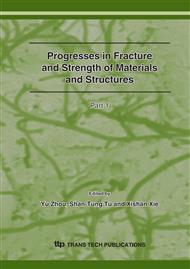p.1283
p.1287
p.1290
p.1294
p.1298
p.1302
p.1306
p.1310
p.1314
Damage Monitoring of Thick CFRP Beam Using Electrical Impedance Changes
Abstract:
Electrical resistance change method has been applied to monitor a delamination crack of a thin CFRP laminate. For a thick CFRP laminate, multiple delamination cracks are made with many matrix cracks, and the electric current in the thick CFRP laminate may not flow in the thickness direction due to the strong orthotropic electrical conductivity. The present study employs an electric impedance change method for the identification of damage location and dimension of the damaged area; applicability of the method is investigated experimentally using thick beam-type specimens fabricated from cross-ply laminates of 36 plies. After making the damage, electrical impedance was decreased. A residual stress relief model was proposed to explain the decrease. From the measured electrical impedance changes, the relationships between the electrical impedance changes and damages are obtained by means of response surfaces. The response surfaces estimated the damage location and dimension of the damaged area exactly even for the thick CFRP laminates. The electrical impedance change method can be used as an appropriate sensor for measurement of residual stress relief due to damages of thick CFRP laminates.
Info:
Periodical:
Pages:
1298-1301
Citation:
Online since:
September 2007
Authors:
Keywords:
Price:
Сopyright:
© 2007 Trans Tech Publications Ltd. All Rights Reserved
Share:
Citation:


